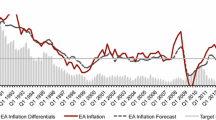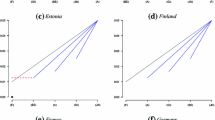Abstract
This article analyzes the inflation process before and after a new country with a middle-income joined the eurozone. It starts with comparative price level gaps in the European single market and with a reformulated basic macroeconomic model for a country adopting the euro. The inflation process in Slovenia is analyzed with the Phillips curve. The Phillips curve before adoption of the euro is a classical equation with the NAIRU and the nominal exchange rate as a control variable. It was expected that the Phillips curve would have to be modified after the euro was adopted. The Phillips curve after the euro was adopted should take into account the initial comparative price level gap, the law of one price, and the Balassa effect. The result is higher differential inflation; that is, national inflation is higher compared with the rate in the eurozone. Differential inflation may have a detrimental effect on export-driven catch-up growth. Instruments for taming inflationary pressure could include a higher unemployment rate and lower growth of labour unit costs.
Similar content being viewed by others
Notes
Before adopting the euro, Slovenia used a definition that expressed the nominal exchange rate as the price of foreign currency in terms of the domestic currency (e.g., EUR 1 = SIT 239.64; SIT = Slovenian tolar).
For more about groupings and differential growth in Europe, see the article by Senjur (2007).
Similar approach has been taken in the economic growth literature dealing with the topic of convergence (Sala-i-Martin 1996).
Data are taken from Eurostat Yearbook 2009 and from issues of earlier years.
It is assumed that there are permanent comparative price level differences that could be regarded as normal or equilibrium. However this question was not investigated.
The author is not aware of any study that calculates a sustainable or even an equilibrium price level gap for Slovenia at the time it adopted the euro. The official Bank of Slovenia exchange rate for the Slovenian tolar (SIT) in relation to the euro on 31 December 2006, which was EUR 1 = SIT 239.64, was taken as the actual conversion rate of tolars into euros on 1 January 2007, when the country adopted the euro. At such a conversion rate, the average level of prices in Slovenia was 26 per cent lower than in the eurozone. At a lower conversion rate, the price level gap would have been lower and there would have been less of a need for higher differential inflation to equalize price levels afterwards (Weyerstrass 2008).
Due to the lack of mobility of labour among eurozone countries, the Phillips curve of the eurozone is determined directly by the output gap as a measure of demand slack at the eurozone level.
Slovenia showed some signs of such movements in 2007–2009. Investment grew by 17% in 2007, and the current account deficit increased close to 5%. Gross foreign debt increased from 15 billion euro in 2004 to over 40 billion euro in 2008. GDP grew by 6.8%, which is above the potential growth rate of the last decade. Such movements on the demand side, caused by the new situation of the euro, contributed to higher inflation in Slovenia in 2007 and 2008. In 2009 the economy turned into a bust situation.
The author and Katja Zajc Kejžar carried out an extensive empirical study of the natural rate of unemployment and the Phillips curve for Slovenia based on quarterly data. It is interesting that the regression above with import prices yielded better results than with the nominal exchange rate. However, annual data yielded better results with the nominal exchange rate (Senjur and Zajc Kejžar 2009). This article focuses more on the results based on annual data. The pass-through effect of the nominal exchange rate on inflation is better reflected by annual data.
Mihaljek and Klau (2008) provide recent empirical estimates of catching-up and inflation in transition economies.
Data are taken from a publication by the Slovenian government’s Institute for Macroeconomic Analyses and Development (UMAR) titled the Poročilo o razvoju (Development Report), Ljubljana, 2009.
References
Allington NFB, Kattuman PA, Waldmann FA (2005) One market, one money, one price. Int J Cent Bank 1(3):73–115
Angelini P, Lippi F (2007) Did prices really soar after the euro cash changeover? Evidence of ATM withdrawals. Int J Cent Bank 3(4):1–22
Angeloni I, Aucremanne L, Ciccarelli M (2006) Price setting and inflation persistence: did EMU matter? Econ Policy 21(46):353–387
Balassa B (1964) The purchasing-power parity doctrine: a reappraisal. J Polit Econ 72(6):584–596
Ball L, Mankiw NG (2002) The NAIRU in theory and practice. J Econ Perspect 16(4):115–136
Baumol WJ (1986) Productivity growth, convergence, and welfare: what the long-run data show. Am Econ Rev 76(5):1072–1085
Blanchard O (2009) Macroeconomics, 5th edn. Pearson Prentice Hall, Upper Saddle River
Borio C, Filardo A (2007) Globalisation and inflation: new cross-country evidence on the global determinants of domestic inflation (= BIS Working Papers no. 227). Bank for International Settlements, Basel
Calmfors L (2001) Unemployment, labor market reforms, and monetary union. J Labour Econ 19(2):265–289
Canavese AJ (1982) The structuralist explanation in the theory of inflation. World Dev 10(7):523–529
De Grauwe P (2007) Precondition for a successful euro adoption. In: Basci E, Togan S, von Hagen J (eds) Macroeconomic policies for EU accession. Edgar Elgar, Cheltenham, pp 206–227
Ėgert B, Drine I, Lommantzsch K, Rault C (2002) The Balassa-Samuelson effect in central and eastern Europe: myth or reality? (= William Davidson Working Paper no. 483, July 2002). William Davidson Institute, Ann Arbor
Ėgert B, Ritzberger-Gruenwald D, Silgoner MA (2004) Inflation differentials in Europe: Past experience and future prospects. Monet Policy Econ 1(May):47–72
Eichengreen B (2002) The enlargement challenge: can monetary union be made to work in an EU of 25 members? Aust Econ Rev 35(2):113–121
Gordon RJ (1997) The time-varying NAIRU and its implications for economic policy. J Econ Perspect 11(1):11–32
Hammermann F, Flanagan M (2009) What explains persistent inflation differentials across transition economies? Econ Transit 17(2):297–328
Jazbec B (2002) Balassa-Samuelson effect in transition economies: The case of Slovenia (= William Davidson Working Paper no. 507, October 2002). William Davidson Institute, Ann Arbor
Johnson OEG (1984) On growth and inflation in developing countries. IMF Staff Pap 31(4):636–660
Lein-Rupprecht SM, Leon-Ledesma MA, Nerlich C (2007) How is real convergence driving nominal convergence in the new EU member states? (= European Central Bank, Working Paper Series, no. 827, November). European Central Bank, Frankfurt
MacDonald R, Wójcik C (2008) Catching-up and inflation differentials in a heterogeneous monetary union: some implications for the euro area and new EU member states. Econ Syst 32(1):4–16
Masten I (2008) Optimal monetary policy with Balassa-Samuelson-type productivity shocks. J Comp Econ 36(1):120–141
McCombie JSL, Thirwall AP (1994) Economic growth and balance-of-payment constraint. Macmillan, Basingstoke
Mihaljek D, Klau M (2008) Catching-up and inflation in transition economies: the Balassa-Samuelson effect revisited (= BIS Working Papers, no. 270, December 2008). Bank for International Settlements, Basel
Rogoff K (1996) The purchasing power puzzle. J Econ Lit 34(2):647–668
Sala-i-Martin XX (1996) The classical approach to convergence analysis. Econ J 106(July):1019–1036
Samuelson PA (1964) Theoretical notes on trade problems. Rev Econ Stat 46(2):145–154
Samuelson PA, Solow RM (1960) Analytical aspects of anti-inflationary policy. Am Econ Rev Pap Proc 50(2):177–194
Senjur M (2007) A development club and groupings in Europe, and growth strategies. Comp Econ Stud 49(4):660–682
Senjur M (2009) The transition experience in retrospect: the labour market transformation was vital. Post Communist Econ 21(2):175–189
Senjur M, Zajc Kejžar K (2009) Naravna stopnja breposelnosti v Sloveniji (Natural rate of unemployment in Slovenia). Unpublished research paper for the Bank of Slovenia
Staiger D, Stock JH, Watson MW (1997) The NAIRU, unemployment and monetary policy. J Econ Perspect 11(1):33–49
Taylor JB (2000) Teaching modern macroeconomics at the principle level. Am Econ Rev 90(2):90–94
Taylor AM, Taylor MP (2004) The purchasing power parity debate. J Econ Perspect 18(4):135–158
Tobin J (1972) Inflation and unemployment. Am Econ Rev 62(1):1–18
Vickers J (2001) Monetary union and economic growth. In: Smets J, Dombrecht M (eds) How to promote economic growth in the euro area. Edward Elgar, Cheltenham, pp 272–298
Weyerstrass K (2008) Economic policies on Slovenia’s road to the euro area. Econ Syst 32(1):92–102
Weyerstrass K, Neck R (2007) A simulation of the macroeconomic effects of introducing the euro in Slovenia. In: Zupančič B, Karba R, Blažič S (eds) Proceedings of the 6th EUROSIM congress on modeling and simulation. EUROSIM 2007, Ljubljana, pp 1–8
Wyplosz C (2006) European monetary union: the dark sides of a major success. Econ Pol 21(46):207–261
Author information
Authors and Affiliations
Corresponding author
Rights and permissions
About this article
Cite this article
Senjur, M. Differential inflation, Phillips curves, and price competitiveness in a new euro-member country. Econ Change Restruct 43, 253–273 (2010). https://doi.org/10.1007/s10644-010-9090-8
Received:
Accepted:
Published:
Issue Date:
DOI: https://doi.org/10.1007/s10644-010-9090-8




